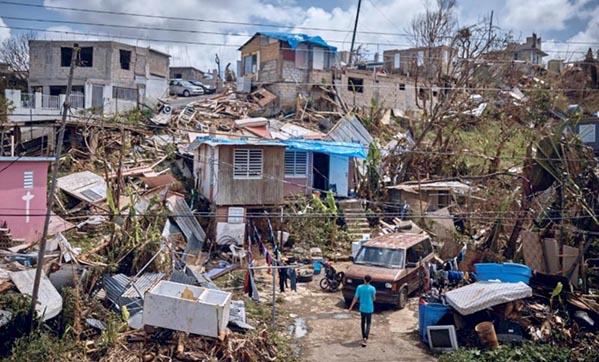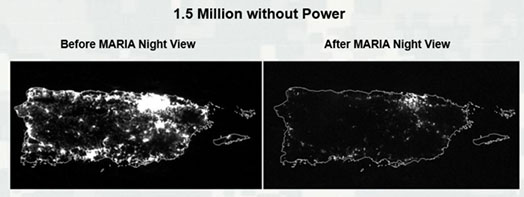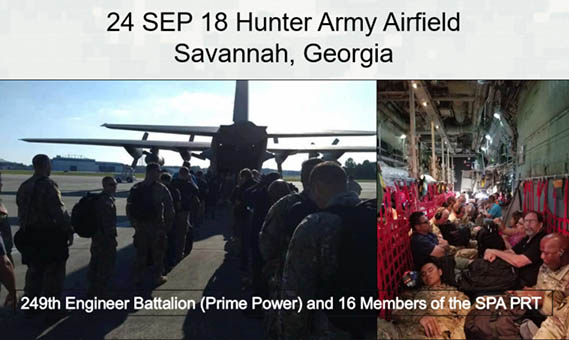It’s been a long year for the U.S. Army Corps of Engineers (USACE) Temporary Emergency Power Planning & Response Teams (PRT). USACE has seven teams and in a normal year, or hurricane season, the teams may, or may not, even deploy. A bad season might see two of the teams deploy for around 45 days and return home – mission complete. But 2017 was different.
According to the National Hurricane Center, more than 99.7 percent of the season's damage was due to three of the season's major hurricanes – Harvey, Irma, and Maria. Another notable hurricane, Nate, was the worst natural disaster in Costa Rican history; Harvey, Irma, Maria, and Nate had their names retired due to their high damage costs and loss of life. Featuring 17 named storms, 10 hurricanes, and 6 major hurricanes, the 2017 season ranks alongside 1936 as the fifth-most active season since reliable records began in 1851.
This season is also one of only six years on record to feature multiple Category 5 hurricanes, and only the second after 2007 to feature two hurricanes making landfall at that intensity. All ten of the season's major hurricanes occurred in a row, the greatest number of consecutive hurricanes in the satellite era, and tied for the greatest number of consecutive hurricanes ever observed in the Atlantic basin since reliable records began in 1851.
The 2017 Atlantic hurricane season was a catastrophic hurricane season that, with a damage total of at least $316 billion and climbing, was the costliest tropical cyclone season on record. With over 4,000 estimated deaths, 2017 was the deadliest season since 2005 and also featured the highest total accumulated cyclone energy (ACE); this season is the only season on record in which three hurricanes each had an ACE of over 40: Irma, Jose, and Maria.
On Sept. 20, 2017, Hurricane Maria made landfall as a Category 5 hurricane with winds of 155 mph near the small city of Humacao.

Two days prior, the Albuquerque District had received notification of a pre-declaration of emergency allowing the team to mobilize. From the entire temporary power team, the Advanced Contracting Initiative (ACI) contractor, Louis Berger, had employees and a staging base at Fort Buchanan, in San Juan from Hurricane Irma, and the 249th Engineer Battalion also had a small contingent in San Juan and the U.S. Virgin islands.
On Sept. 22, the team flew to Atlanta with plans to fly onward to San Juan, but so were every first responder team on the East Coast. The CDC and doctors “bumped” the team on Sept. 23, and on the 24th the SPA PRT was able to convince the other responders to send a five-person advanced party on the one commercial flight into the badly damaged airport. The remaining 16 team members were left to find a way to follow.
Once on the ground, the five team members stumbled their way through a steam-filled gate area with hundreds of stranded tourists and Puerto Rican families attempting to escape the carnage of the island. One hundred percent of island power for well over 1.5 million people was out.

There were no cell phones, no air conditioning, no signal towers, no telephone GPS, no radar, no security, and no computers. And if that wasn’t enough, the government cell phones the team had were on America’s largest network, Verizon. But Verizon was not a service-provider in Puerto Rico so other carrier phones would have to be flown in. The rental car agency had a typewriter and hand written contracts based on rates that the staff could remember from before the power went out and that’s how the team started. It was the Stone Age revisited.
Without a good feel for what was ahead, the team pushed on to the San Juan Convention Center near one of the island’s three deep-water piers. There, Army cots and a bottle of water waited. The rest of the team along with the remaining members of the 249th Engineer Battalion (Prime Power) had seized the initiative, driven to Dobbins Air Reserve Base and boarded a USAF C130 cargo plane. They joined the advance party at 0200 hours, Sept. 25, in the Convention Center and the work began.

Words could not describe the days that followed as the public, media, and government at all levels became aware of the enormous scope of this event.
Imagine every hospital; police station; government agency at all levels; laboratories; flood-water pumping station; drinking-water pumping station; airfield; ferry terminal; nursing home; correctional facility; and commercial food and drug store distributer was out. There were no road signs and the stop signals were gone. FEMA struggled with priorities. Where should we install our first generators? No one understood that the team only had about 70 fully mission capable DLA/FEMA generators in the Incident Support Base. The team desperately needed more large generators, but how many? The entire world was watching as debris, critical infrastructure, roofing, temporary housing, and the temporary power teams from USACE began their efforts.
Within two weeks, the PRT asked for 400 generators and the U.S. logistics system was shocked. They were even more shocked when the PRT responded with… “to start with.” Forty-six days later on Nov. 4, 2017, the team would leave Puerto Rico with 434 generators installed. The numbers exceeded Katrina, Sandy, Harvey and Irma combined, and they would continue to climb exponentially as the next tier of importance would step forward for power – nearly 1,300 schools could not graduate their students in May without a return to the classroom.
As the effort increased, so too did the logistics. There were no hotels left to house 6,000 federal employees. FEMA contracted cruise ships like the Carnival Fascination to house workers. The USS Comfort, a U.S. Navy vessel would serve as an emergency care hospital ship in San Juan. The team would assist in the coordination for log bases in Fajardo, Ponce, and Aguadilla, and a second staging area at Fort Buchanan. Every 10-18 days, 150 generators from around the world would enter the port of San Juan.
Meanwhile the rain kept coming. As communications began to be restored, tasking requests for assistance increased. In November and December, the requests for assistance increased for nearly 2,000 generators to be installed – a mind-blowing five times the efforts of prior historical peaks combined!
As USACE began the daunting task of restoring the main power grid and repairing the failing Guajataca Dam, it also received the mission assignment to repair generators that may be already on a facility, but not functioning. As of Thanksgiving 2017, the SPA PRT would be asked to go back to Puerto Rico the day after Christmas to execute this non-federal generator repair mission.
The PRT from the District would have to rebuild and train the entire PRT during the holidays. Twenty team members left Albuquerque between Dec. 26 and Jan. 3, 2018, staying in Puerto Rico through Feb. 9.
By Jan. 19, the team was averaging one repair per day. Although there was a Quality Assurance monitoring mission, it was clear that USACE needed to find a way to terminate this mission through FEMA due to spiraling costs. The missions would close during the team’s next deployment in the first week of April after just more than 400 generators were repaired.
Why was this mission so difficult? The devastation was epic in size, scope and magnitude. Infrastructure was weak in the first place. Government bureaucracy is always an impedance to fast movement, and the frequent rain in the Caribbean would break things that were functioning. Every time decision makers were ready to say “end of mission,” the fragile power system would fail and the population naturally would panic.
Another point of interest: beginning in January 2018, for the first time the Corps was tasked by FEMA to provide micro-grids to communities. This requires a string of two to four 1.8 MW generators operating in parallel to power an entire community that may be cut off from the rest of the island. At one point the teams provided nine micro-grid communities with power for their homes and businesses. As USACE de-mobilizes, only the two on the islands of Vieques and Culebra will be left under contract service for the foreseeable future.
By the end of March, the federal generator installs were at 879 installed generators in the field being serviced by 70 PRT members and over 850 contracted employees.
The District was notified that the team would return in July – August to close the mission. The Hawaii team returned to the Pacific Ocean area of focus, Pittsburgh, Savana, and Tulsa teams had just deployed and were on the ground, and the banks of the Mississippi were flooding in Memphis. Suddenly, within days, the District’s team would be asked to go back to Puerto Rico, two rotations early on April 15 until May 29. Again, the team had to urgently rebuild, train, and now compete for membership with the summer recreation season at the dams and the construction build-up for the summer. The team needed 71 members and was only able to deploy 14 experienced cadre members supplemented by 16 District personnel – but for the first time, the team leadership was seasoned, trained, and had processes in place.
The PRT boarded the plane for Albuquerque at the beginning of the 2018 hurricane season with over 700 generators still on the island, but the tide had shifted from installation to de-installation as fast as possible without jeopardizing the situation in Puerto Rico. June and July would see steady progress by Tulsa and Pittsburgh districts’ power teams, but the mission would continue fueled by fears of the next hurricane, which fortunately would not come, but time was marching on. The SPA Temporary Power PRT would be tasked to attempt to close the mission from Sept. 21 – Nov. 4, 2018.
Through most of June to August no hurricanes of any consequence occurred, but suddenly in September Hurricane Lane struck the island of Hawaii, Mangkhut hit Guam, Olivia threatened Oahu, Florence threatened the East Coast, followed by hurricanes Isaac and Helene.
As tickets and reservations had been made for Puerto Rico, the team received a pre-declaration of an emergency on Monday, Sept. 10, and 13 members were diverted to Virginia to battle the damages of Hurricane Florence. By Saturday, Sept. 16, the team was no longer needed in Virginia. The members returned to Albuquerque on Sunday and the advance party flew at 0500 hours in the morning of Sept. 18, to San Juan to relieve the Memphis PRT on-time, as originally scheduled. The remainder of the team had been on standby to receive orders and joined the advance party on Sept. 21, 2018, one year after the most devastating hurricane to reach Puerto Rico shores had left the island – the anniversary team had arrived.
The de-install mission continues today. So far, the team had 55 generators left in service including seven on the two remaining micro-grids. FEMA is writing a contract to pick-up the remaining generator maintenance and installation plan for the remaining installed generators and the 630 generators remaining in four FEMA warehouses for the future. The Tulsa Team has been tasked to basically close the books on this mission assignment through Nov. 30, and thereby ending recovery and moving into FEMA’s restoration phase which the Corps will indirectly support through its Jacksonville District, Antilles Area Office operations in San Juan.
USACE can be justifiably proud of each member of its recovery PRT team for 2017-18 deployments. Members of the District team deployed as many as 200+ days and five times while many others on the team also deployed in support of South Pacific Division’s Northern California Wildfire debris missions.
Building Strong and Reducing Disaster Risk!